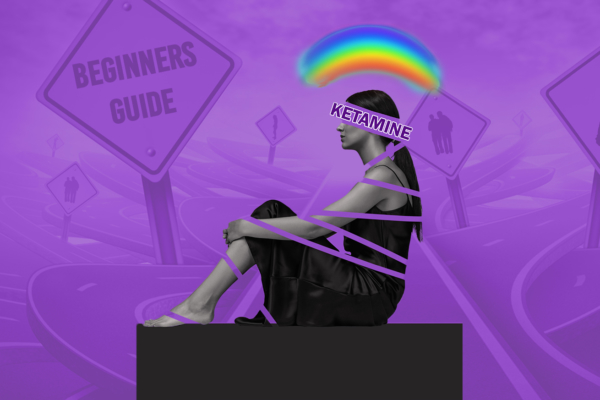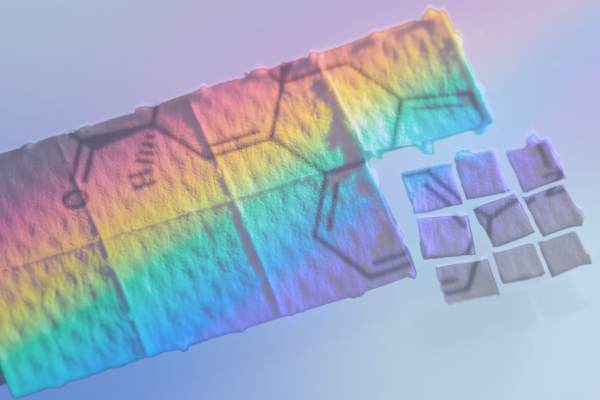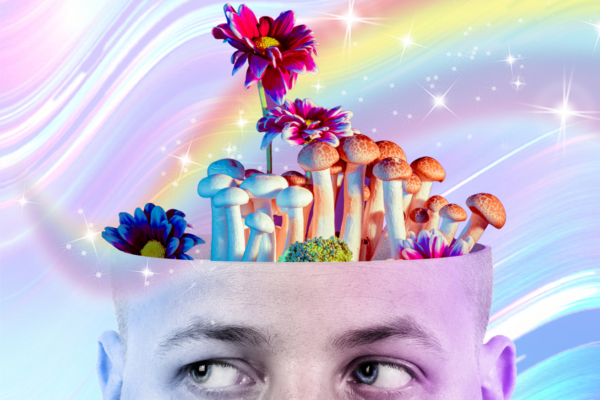
It’s been a high-profile year for ketamine. A variety of research studies have investigated how this dissociative can help address many of life’s challenges, including marital problems to treating psychiatric disorders such as depression, and even leading a billion-dollar empire.
While most may be aware that ketamine is a general anesthetic, the substance is also used off-label in diverse medical scenarios. Off-label use refers to the practice of prescribing a medication for the treatment of a condition outside of its original medicinal intent. While the term sounds suspicious, this is a customary practice, and it mainly happens due to outdated labeling. When administered in high doses, ketamine infusions can lead to powerful psychedelic experiences and create neuroplasticity. Although ketamine has been hailed as a breakthrough therapy for depression and now thousands of ketamine clinics across the United States and Canada administer the substance for depression, anxiety and PTSD, ketamine still remains a controlled substance in the United States and other countries around the globe.
Recreationally, ketamine is used at rave parties and low-key hangouts alike due to its dissociative effects and psychedelic properties. In these scenarios, it’s commonly ground into a powder and snorted, while medical professionals opt to inject it intravenously, which changes its effects and their onset.
Now that we’ve established its therapeutic potential beyond anesthesia, here’s a list of the ten most meaningful studies exploring ketamine’s efficacy in treating depression, substance abuse disorders, and other mental health illnesses.
01. Ketamine versus ECT for Nonpsychotic Treatment-Resistant Major Depression
In a groundbreaking study, Amit Anand et al. put ketamine head-to-head with electroconvulsive therapy (ECT) to assess their effectiveness in treating treatment-resistant depression (TRD). As a considerable portion of depression patients remain unresponsive to standard antidepressant medications, this research could signal a shift in therapeutic approaches.
The findings revealed that:
- 55.4% of patients in the ketamine group exhibited a significant reduction in depressive symptoms.
- In comparison, 41.2% of patients undergoing ECT showed similar improvement.
Notably, ketamine was generally well-tolerated with dissociation being the most common side effect, whereas ECT was associated with side effects like memory loss.
The results suggest that ketamine could represent a more favorable option for TRD, potentially leading to a paradigm shift in treatment methodologies due to its higher patient preference and lower side effect profile.
02. Whole-Brain Mapping Reveals the Divergent Impact of Ketamine on the Dopamine System
Malika Datta et al.’s study offers a novel perspective on how ketamine use impacts the brain’s dopamine system in mice, which has implications for mood and metabolism regulation.
The findings revealed that:
- Ketamine decreased dopamine neurons in the midbrain, which could explain the emergence of schizophrenic-like symptoms due to abuse.
- Conversely, it increased dopamine neurons in the hypothalamus, hinting at potential treatments for eating disorders.
This study underscores the importance of targeted application in ketamine treatments to mitigate adverse effects and enhance therapeutic outcomes.
03. Real-World Effectiveness of Repeated Ketamine Infusions for Treatment-Resistant Bipolar Depression
In Farhan Fancy et al.’s study, the effectiveness of ketamine for treating treatment-resistant bipolar depression was evaluated. Conducted in a community clinic setting, the research monitored the response of patients to ketamine treatment.
The findings revealed that:
- A positive response to ketamine was observed in 35% of patients.
- Remission was achieved in 20% of cases, signaling a significant decrease in symptom severity.
These insights highlight ketamine’s potential as a beneficial treatment for bipolar depression, opening avenues for future therapeutic strategies.
04. Ketamine and Its Metabolites: Potential as Novel Treatments for Depression
Kai Zhang et al.’s research explores the antidepressant potential of ketamine, particularly focusing on its rapid action after a single dose. The study notes ketamine’s dual nature: its ability to induce dissociation and its therapeutic effects on mood through neuroplasticity.
The findings revealed that:
- Ketamine’s antidepressant effects may be linked to its role as an NMDAR antagonist.
- (R)-ketamine is suggested to be a potentially safer enantiomer for therapeutic use.
The study calls for further investigation into ketamine’s mechanisms to develop safer and more effective treatments for depression.
05. Weapons of Stress Reduction: (R,S)-Ketamine and Its Metabolites as Prophylactics for the Prevention of Stress-Induced Psychiatric Disorders
Briana K. Chen et al.’s study investigates ketamine’s role in enhancing stress resilience, potentially preventing stress-related psychiatric disorders.
The findings revealed that:
- Ketamine may act as a prophylactic, bolstering the brain’s resilience to stress.
- This could be significant in preventing conditions like PTSD, GAD, and MDD.
These insights suggest ketamine’s preventative applications in mental health, marking a step forward in psychiatric disease prophylaxis.
06. Ketamine as Advanced Second-Line Treatment in Benzodiazepine-Refractory Convulsive Status Epilepticus in Children
In a critical study, Silvia Burrati et al. focused on the use of ketamine for children experiencing benzodiazepine-refractory convulsive status epilepticus (RSE), a severe form of epilepsy. This research is particularly important because RSE represents a significant challenge in pediatric neurology, often resistant to standard treatments.
The findings revealed that:
- Ketamine can rapidly affect the brain, addressing seizures effectively.
- It poses fewer significant side effects, even at doses effective for RSE.
The research supports a shift in medical perspectives towards using ketamine as a primary treatment for RSE in children.
07. Sustained Antidepressant Effect of Ketamine Through NMDAR Trapping in the LHb
Researchers at Zhejiang University conducted an insightful study into the sustained antidepressant effects of ketamine. They explored how ketamine interacts with specific brain regions, particularly the lateral habenula (LHb), known to be hyperactive in depressive states.
The findings revealed that:
- Ketamine’s trapping in NMDARs within the LHb significantly reduces its hyperactivity.
- Direct targeting of LHb with ketamine could enhance therapeutic outcomes with fewer side effects.
This study is pivotal in understanding ketamine’s mechanism of action, paving the way for more precise and effective depression treatments.
08. The Therapeutic Role of Ketamine and Esketamine in Treating Psychopathological Domains of Depression
Muhammad Youshay Jawad et al. approached the study of ketamine’s effectiveness in treating depression from a detailed perspective. They analyzed its impact across various psychopathological domains, acknowledging the complexity and multifaceted nature of depressive disorders.
The findings revealed that:
- Ketamine shows a significant impact in reducing symptoms of suicidality.
- Its effectiveness in other domains, such as cognition and anhedonia, is yet to be fully understood.
Their research contributes to a nuanced understanding of ketamine’s potential benefits and limitations in comprehensive depression treatment.
09. Repurposing Ketamine to Treat Cocaine Use Disorder: Integration of Artificial Intelligence-Based Prediction, Expert Evaluation, Clinical Corroboration and Mechanism of Action Analyses
In a groundbreaking study led by Zhenxiang Gao, artificial intelligence was employed to assess ketamine’s effectiveness in treating cocaine use disorder (CUD). This innovative approach signifies a leap forward in utilizing technology to uncover new therapeutic potentials of existing drugs.
The findings revealed that:
- Patients with CUD showed more significant improvement when treated with ketamine.
- Patients with Cocaine Use Disorder (CUD) prescribed ketamine for anesthesia had a 1.98 times higher rate of CUD remission, and those prescribed it for depression had a 4.39 times higher remission rate compared to matched controls.
- The study exemplifies how AI can revolutionize drug repurposing and clinical research.
This research highlights the emerging role of AI in healthcare, offering new insights into ketamine’s broader therapeutic applications.
10. Randomized Trial of Ketamine Masked by Surgical Anesthesia in Patients With Depression
In a unique clinical trial, researchers tested ketamine’s efficacy in treating major depressive disorder (MDD) under the guise of routine surgical anesthesia. This approach allowed for an anonymous study, free from patient and staff biases about ketamine’s known effects.
The findings revealed that:
- Patients unknowingly receiving ketamine experienced significant improvements in depression symptoms.
- The study’s blinding led to fascinating insights into the psychological aspects of treatment expectations.
This study offers a fresh perspective on ketamine’s antidepressant properties, emphasizing the interplay between psychological expectation and pharmacological action.
As we have seen from these ten studies, ketamine has many utilities for psychiatric and neurological disorders, as well as certain limitations and downsides.
Remember that ketamine is administered differently in clinical contexts, and you can’t expect to get these mental health benefits from recreational use. Ketamine therapy requires a team of experts who can guide you through the process and help you integrate the insights gained from the experience into your life.
Also, keep in mind that ketamine has potential for abuse, which can lead to brain cell death, severe cognitive issues, and bladder problems. Occasional use is fine, but you should seek professional help if you suspect that you’re developing an addiction.
References
- Anand, A., Mathew, S. J., Sanacora, G., Murrough, J. W., Goes, F. S., Altinay, M., Aloysi, A. S., Asghar-Ali, A. A., Barnett, B. S., Chang, L. C., Collins, K. A., Costi, S., Iqbal, S., Jha, M. K., Krishnan, K., Malone, D. A., Nikayin, S., Nissen, S. E., Ostroff, R. B., Reti, I. M., … Hu, B. (2023). Ketamine versus ECT for Nonpsychotic Treatment-Resistant Major Depression. The New England journal of medicine, 388(25), 2315–2325. https://doi.org/10.1056/NEJMoa2302399
- Datta, M. S., Chen, Y., Chauhan, S., Zhang, J., De La Cruz, E. D., Gong, C., & Tomer, R. (2023). Whole-brain mapping reveals the divergent impact of ketamine on the dopamine system. Cell reports, 113491. Advance online publication. https://doi.org/10.1016/j.celrep.2023.113491
- Fancy, F., Rodrigues, N. B., Di Vincenzo, J. D., Chau, E. H., Sethi, R., Husain, M. I., Gill, H., Tabassum, A., Mckenzie, A., Phan, L., McIntyre, R. S., & Rosenblat, J. D. (2023). Real-world effectiveness of repeated ketamine infusions for treatment-resistant bipolar depression. Bipolar Disorders, 25(2), 99-109. https://doi.org/10.1111/bdi.13284
- Zhang, K., Yao, Y., & Hashimoto, K. (2023). Ketamine and its metabolites: Potential as novel treatments for depression. Neuropharmacology, 222, 109305. https://doi.org/10.1016/j.neuropharm.2022.109305
- Chen, B. K., & Denny, C. A. (2023). Weapons of stress reduction: (R,S)-ketamine and its metabolites as prophylactics for the prevention of stress-induced psychiatric disorders. Neuropharmacology, 224, 109345. https://doi.org/10.1016/j.neuropharm.2022.109345
- Buratti, S., Giacheri, E., Palmieri, A., Tibaldi, J., Brisca, G., Riva, A., Striano, P., Mancardi, M. M., Nobili, L., & Moscatelli, A. (2023). Ketamine as advanced second-line treatment in benzodiazepine-refractory convulsive status epilepticus in children. Epilepsia, 64(4), 797-810. https://doi.org/10.1111/epi.17550
- Ma, S., Chen, M., Jiang, Y. et al. Sustained antidepressant effect of ketamine through NMDAR trapping in the LHb. Nature 622, 802–809 (2023). https://doi.org/10.1038/s41586-023-06624-1
- Jawad, M. Y., Di Vincenzo, J. D., Badulescu, S., Teopiz, K. M., Tabassum, A., Ceban, F., Mckenzie, A., Meshkat, S., Rosenblat, J. D., Ho, R. C., & McIntyre, R. S. (2023). The therapeutic role of ketamine and esketamine in treating psychopathological domains of depression. Neuropharmacology, 223, 109299. https://doi.org/10.1016/j.neuropharm.2022.109299
- Gao, Z., Winhusen, T. J., Gorenflo, M., Ghitza, U. E., Davis, P. B., Kaelber, D. C., & Xu, R. (2023). Repurposing ketamine to treat cocaine use disorder: Integration of artificial intelligence-based prediction, expert evaluation, clinical corroboration and mechanism of action analyses. Addiction, 118(7), 1307-1319. https://doi.org/10.1111/add.16168
- Lii, T. R., Smith, A. E., Flohr, J. R., Okada, R. L., Nyongesa, C. A., Cianfichi, L. J., Hack, L. M., Schatzberg, A. F., & Heifets, B. D. (2023). Randomized trial of ketamine masked by surgical anesthesia in patients with depression. Nature Mental Health, 1(11), 876-886. https://doi.org/10.1038/s44220-023-00140-x





